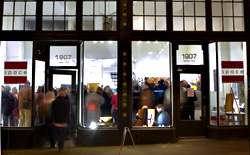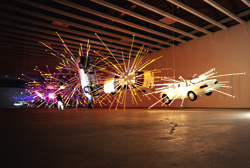Second Avenue and University Street downtown was once a lively corner. Seattle Art Museum visitors and Benaroya Hall devotees would at least peer in the bright windows of Kimzey/Miller Gallery and often stop in. During the dot-com boom, the art market was hot. But no longer. Now there’s a bus stop nearby that shelters commuters and stragglers, SAM is closed for expansion, and new construction clogs the streets and diverts foot traffic elsewhere.
“The neighborhood has changed,” says Pat Kimzey of Kimzey/Miller, who is calling it quits after 30 years in the business. Kimzey, 61, says he’s leaving out of choice, though this decision is tempered by a few factors beyond his control. His business and life partner, Terry Miller, died a year and a half ago. Miller was the charismatic one with the arts background. Kimzey was the studious one crunching the numbers behind the scenes. It was the perfect match. “He had the eye and imagination, and I had the sharp pencil,” says Kimzey.
The gallery specializes in eye-catching, nonthreatening contemporary art, like Gregg Robinson’s glossy geometric paintings and Misty Martin’s photorealist images of Pike Place Market and other popular Seattle locales.
Kimzey’s one regret is that he was unable to renew his lease in time to sell the business intact. “It would have been nice to give the artists a home,” he says. Only some of Kimzey’s 23 artists have found new representation. It’s unclear what’s going to happen to the space once the gallery closes at the end of May. The building’s owner doesn’t know.
Kimzey says he’s ready to move on. “Thirty years seemed enough to devote to just one thing.” And that’s not a bad run for an art gallery. Only a handful in the area have lasted that long—Francine Seders, Woodside/Braseth, and Foster/White were established in the 1960s, while Sam Davidson and William Traver opened their galleries in the 1970s.
Meanwhile, five blocks to the north, Guy Warren Borgford is jumping into the gallery business with his hip new venture, Space, a former clothing store on Second at Stewart on the edge of Belltown.
He opened recently with a variety of work by seven lesser-known local artists, as well as his own abstract canvases. Borgford, a 41-year-old Canadian transplant, has been officially painting for about a year, though he has kept his day job at RealNetworks. Space is a decent size with lots of natural light from a 20-foot wall full of windows, which were steamed up provocatively on his first First Thursday. (Borgford plans to install a fan.) His aesthetic ranges from the abstract cubist canvases of Carlyle Moore to Brian White’s creepy dismembered Kewpie doll shadowboxes.
“I have some really fresh young talent showing this month and some very diverse works in the pipeline.” At the official opening Feb. 9, Borgford had an estimated 300 people come through, went through six cases of wine, and had a DJ spinning in the loft space. Oh, and the gallery also sold five paintings.
“I think we have a very different approach to business than most galleries. We are focused on Space as an event venue, with art being the cornerstone or theme of the venue.” To that end, Space is also seeking bookings for fund-raisers and private parties. That will pay the bills, says Borgford, who reasons, “To be a startup gallery with no clientele and just rely on selling art would be suicidal.” Borgford is also offering the upstairs loft as a crash pad for out-of-town artists.
This seems a genuine labor of love. And energy. Borgford and his two partners pulled it all together in a matter of weeks for under $10,000.
Asked his advice for someone starting a new gallery in 2006, Pat Kimzey laughs. “I would say ‘Good luck.’ It’s a very challenging time we’re in right now.” But the first essential ingredient to a successful gallery, says Kimzey, is “a good business sense.” After that, good art also helps. And a decent location.
Brenda Tipton, publisher of Art Guide Northwest, a twice-yearly directory of galleries, museums, and artists, estimates there are currently around 91 art galleries in the Seattle area. She has seen art spaces come and go.
“My experience has been that many [people] open up only with a B.F.A., no money, and a little talent but think they will make it big in the art world. They soon find out it’s a serious business and close up within months.”
Borgford hopes to defy those odds. Kimzey, meanwhile, plans to visit New Zealand after he closes shop in a few months, and start to enjoy art for art’s sake.








